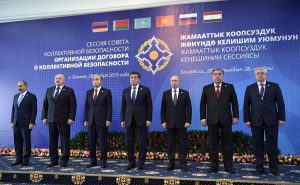On November 27-28, the heads of the six members of the Collective Security Treaty Organization (CSTO) gathered in Bishkek, Kyrgyzstan for a series of meetings, including a session of the organization’s Collective Security Council. The headline items include a joint statement expressing regret about the termination of the Intermediate-Range Nuclear Forces (INF) Treaty and concern over the future of the Strategic Arms Reduction Treaty (New START). The organization also established two new membership categories, observer and partner, in an effort to expand.
The meetings, which closed out Kyrgyzstan’s term as chair, were attended by Armenian Prime Minister Nikol Pashinyan, Belarussian President Alexander Lukashenko, Kazakh President Kassym-Jomart Tokayev, Kyrgyz President Sooronbai Jeenbekov, Russian President Vladimir Putin, and Tajik President Emomali Rahmon.
At present, due to a dispute last year over who had the right to chose the CSTO’s formal head, the organization is still led by Acting Secretary General Valery Semerikov. This is not the first time the CSTO has had difficulty selecting a head. As of January, though, Stanislav Zas, secretary of state of Belarus’ security council, will be the new CSTO head.
A military alliance aimed at collective defense among six former Soviet states, the CSTO was founded in 1992 and is often compared to NATO — though the comparison is arguably weak. The group is largely viewed as a Russian security project, an apparatus to boost its influence across the region. The CSTO held five joint training exercises in 2019 and has a bevvy of associated initiatives.
Positioning itself as an open and diplomatic grouping, the CSTO has begun implementing procedures to welcome observer and partners in to the group. This was almost comically reported in the English version of Xinhua under the headline, “Russia to help CSTO countries make more friends: Putin.” According to Turkey’s Anadolu Agency, Afghanistan and Serbia have become observers.
Uzbekistan has joined the CSTO twice and left twice, 1994-1999 and 2006-2012.
Illustrating a significant synergy with Russia’s interests, in its joint statement on Thursday, the heads of the CSTO said they were “concerned over the worsening international security situation and weakening of the legal mechanisms for its maintenance.”
“We regret the termination of the Intermediate-Range Nuclear Forces Treaty and are deeply concerned about the future of the Strategic Arms Reduction Treaty, which expires in February 2021. In this regard, we hope for the extension of this fundamentally important treaty,” the statement continued.
The CSTO heads are also reportedly concerned over the state of the Afghan-Tajik border. Acting Secretary General Semerikov claimed that there are “already several tends of thousands” of militant forces, including Islamic State, in the areas near the Afghan-Tajik border.
This line of argument is familiar, even though others report that northern Afghanistan is largely under the dominion of the Taliban, rather than forces related to the Islamic State. Claims of Islamic State’s presence are often vague and unverifiable.
For example, the recent violent incident near the Uzbek-Tajik border, which the Tajik government claims involved a group of Islamic State operatives who crossed over from Afghanistan, has only become more muddled. This week a representative of Tajikistan’s State Committee for National Security, as reported by RFE/RL, “said at a conference in Dushanbe on November 25 that nine men, 11 women, and 13 children between the ages of 4 years and 15 years were among the attackers on a border post near Uzbekistan…” That contradicts both the government’s earlier numbers and the claim by the Islamic State (by masked individuals) of responsibility.
Following the summitry in Bishkek, Kyrgyzstan’s Jeenbekov and Tajikistan’s Rahmon traveled to Tashkent to participate in what has been billed as the second summit of Central Asia’s leaders. Tokayev, however, went back to Kazakhstan.
Hosted by Uzbekistan’s President Shavket Mirziyoyev, the summit included Jeenbekov and Rahmon as well as Turkmenistan’s President Gurbanguly Berdimuhamedov — who attended for the first time, having skipped the first summit in the Kazakh capital, then known as Astana in March 2018). Also in attendance was Kazakhstan’s Nursultan Nazarbayev, who technically resigned from the presidency in March 2019, derailing the second summit of Central Asian leaders that was originally scheduled for April 2019.
Nazarbayev’s appearance at the summit, instead of Tokayev, will raise eyebrows (though not too far; no one is surprised). Kazakhstan’s first president continues to hold significant powers in the country and continues to pop up at summits where one would assume the sitting president of Kazakhstan would be.

































